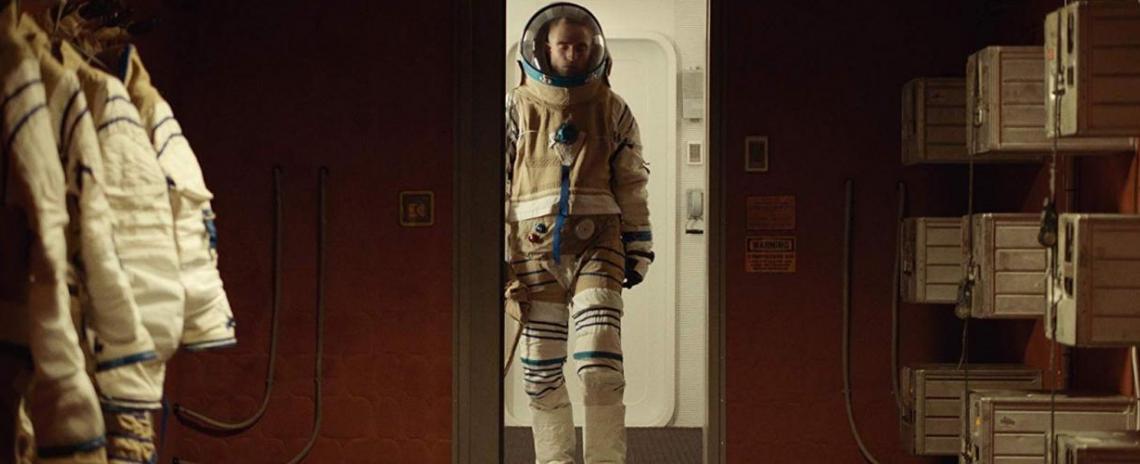There are bucket-loads of bodily fluids – blood, semen, breast milk – in High Life, including some inexplicable substances that come pouring out of the “Fuck Box” after its use by a crew member of a spaceship prison. That’s probably enough information to sharply divide potential viewers into either “Ew, no” or “Yes, please” camps, but it’s also notable that this beguiling trip into a (literal) black hole comes from Claire Denis, a filmmaker whose 30-odd-year output has produced at least a couple of masterpieces – Beau Travail (2000) and 35 Shots of Rum (2008) – and several films that only fall slightly short of such high praise – including Trouble Every Day (2001), Friday Night (2002), and Let the Sunshine In (2018).
Although the wonky and ponderous High Life is Denis on a large scale – with its space-odyssey milieu, an all-English-speaking cast, marquee star of Robert Pattinson, and backing from distributor A24 – it is nevertheless of a piece with the French master’s body of work. Her elliptically structured films – crafted from elegantly rendered pieces sewn together with emotional rather traditionally narrative purpose – often suspend viewers in a state of confused awe until everything miraculously clicks, often to devastating ends. Within these halls of mirrors, Denis is concerned with colonialism, sex, violence, abuses of power, and the experiences of the othered, but these are all explored in the context of her primary foci: desire, intimacy, and the great gulf that often exists between them.
In this regard, High Life is a compendium of Denis’ predominant working modes and themes. Structurally, the film is built around three shifting narrative modules. The first centers on Monte (Pattinson), the lone adult passenger of claustrophobic spaceship with an interior that bears the marks of a turbulent past. Monte’s only company is a baby whom he’s raising with the help of an automated computer teaching it language (imagine HAL 9000 repeating “da da” ad nauseam) and the ship’s organic garden. (The natural and the oppressive manmade commingle throughout the film.) High Life’s aesthetic values also extend the metaphor. The ship’s minimal, lo-fi design reads Silent Running (1972) by way of Nicolas Winding Refn’s neon-lit grunginess. Meanwhile, French special-effects house BUF (David Lynch’s Twin Peaks: The Return [2017]) handles the realization of warping into black holes (and whatever happens in that Fuck Box) with its purposefully handmade-looking digital effects.
This largely dialogue-free section of High Life resembles the best and most patient filmmaking of Denis’ career, including a title card that promises an unfortunately unfulfilled wit. The second narrative module makes up the bulk of the film and is less successful. Although the filmmaker would likely shudder at the thought of this kind of pat focalization – she’s stated she thinks the most interesting parts of films lie within the cuts – it’s ostensibly a flashback to the ship’s origins, purpose, and violent downfall. Monte is a just one of the inmates of this co-ed prison ship, which was blasted into space with two lofty missions in mind: harvest the energy of a black hole in order to save Earth, and determine if procreating in space is a possible alternative. All of the passengers are criminals, and the ship becomes a hotbox of mounting interpersonal tension between already volatile and hopeless individuals.
Unlike Denis’ other stab at genre revisionism with the spare and melancholy vampire tragedy Trouble Every Day, these sections of High Life are prone to narrative hand-holding and overexplaining, lacking her trademark elegance and nuance. Chief among the issues with this particular “act” is its superficiality, especially with supporting characters lacking depth and acting simply as pretty ciphers (Agata Buzek as Chandra and André Benjamin as Tcherny, for example). This even largely applies to Boyse (the always otherworldly Mia Goth), Monte’s would-be romantic foil. Even after her agency is completely stripped away and her futile attempt to regain it goes awry, the character mostly just represents thematization of the abuses of power. Elsewhere, the superficial is just as prevalent: Boyse’s playful moment with the gravity-defying glove from her space suit should be one of classically Malickian wonder, but it instead resembles the surface preciousness that characterizes Malick’s recent works.
This can likely be blamed on these fresh-faced performers being unattuned to the Denis universe, the script – by the director, her frequent collaborator Jean-Pol Fargeau, and newbie Geoff Cox – lacking the foundation necessary for subtlety, or a combination of both. Pattinson, easily one of the best of his generation, transcends the material with the right modulations of boredom, grace, regret, and guilt. He’s matched by Juliette Binoche (returning just a year after her remarkable turn in Let the Sunshine In) as his antagonist, Dibbs, the hypersexual “mad scientist” hellbent on accomplishing “Mission B” by any means necessary. More so than the other performers, Binoche carries Denis’ reduction of human behavior into animal urges both carnal and carnivorous – her bucking-bronco ride in the aforementioned Fuck Box is among the most presentational scenes in any Denis film, for better or worse.
Thankfully, the third module forgoes the banal provocations of the second, warping into a contemplative existentialism that nearly erases (but cannot fully justify) any qualms about what precedes it. Here, Monte attempts to carry out “Mission A” with the help of a femme fatale figure – a film noir archetype Denis says was partially the impetus for High Life. The conflation of heady science fiction with hard-nosed noir helps to realize the portrait of human fatalism throughout, but the film’s final mind- and time-bending beats beg whether humanity can transcend its innate navel-gazing in an attempt to fully understand its role in the cosmos. If the final question Denis proposes is worthy of exploration – whether of the self, others, or beyond – she’s proven that she’s the one to take that journey with, no matter how bumpy it might be.
Rating: B


